Menus
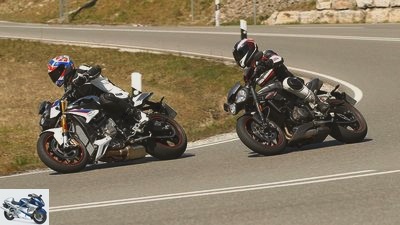
bilski-fotografie.de
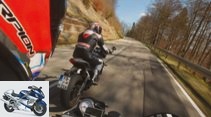

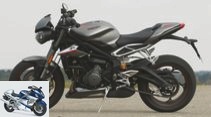
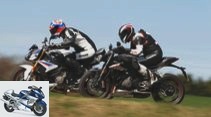
17th photos
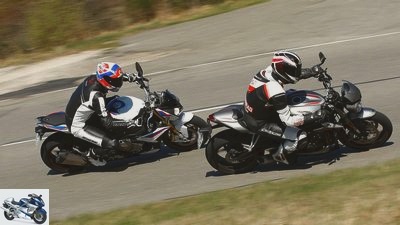
bilski-fotografie.de
1/17
Power makes you fast. But is that really true on the country road? Or does a lot of performance just mean stress for the driver and material? A self-experiment with Triumph’s new Street Triple RS and BMW’s Kraftnackedei S 1000 R must clarify that.
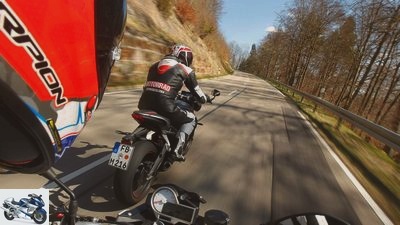
bilski-fotografie.de
2/17
Power in abundance – On the country road in pair skating, full power is rarely needed.
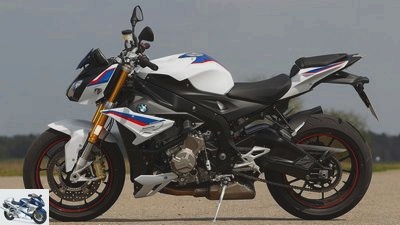
bilski-fotografie.de
3/17
Water-cooled four-cylinder in-line engine, 999 cm³, 121.0 kW (165 hp at 11,000 rpm, 114 Nm at 9250 rpm, Euro 4, aluminum bridge frame, upside-down fork, seat height 814 mm, 120/70 ZR17 tires and 190/55 ZR17, weight with a full tank of 207 kg, wheelbase 1439 mm, steering head angle 65.2 degrees, caster 99 mm, tank capacity 17.5 liters, price of test motorcycle 16,340 euros including ancillary costs
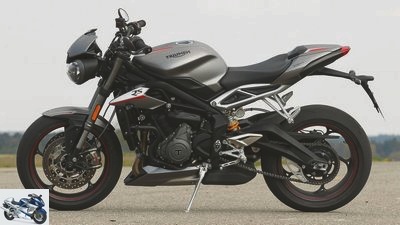
bilski-fotografie.de
4/17
Water-cooled three-cylinder in-line engine, 765 cm³, 90.0 kW (123 PS) at 11 700 rpm, 77 Nm at 10 800 rpm, Euro 4, aluminum bridge frame, upside-down fork, seat height 825 mm, tires 120 / 70 ZR17 and 180/55 ZR17, weight with a full tank of 190 kg, wheelbase 1410 mm, steering head angle 66.1 degrees, caster 100 mm, tank capacity 17.4 liters, price of test motorcycle 12,050 euros including ancillary costs.

bilski-fotografie.de
5/17
Catch me if you can – In the sprint, the BMW Triumph shows a long nose, is ahead.
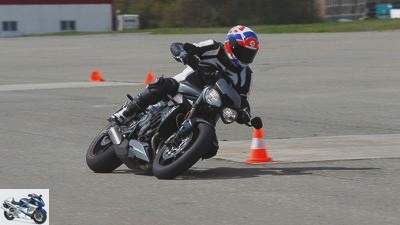
bilski-fotografie.de
6/17
Back and forth in the roundabout: the handling course is the essence of a winding country road, dispenses with long straights, focuses on handling and feedback.
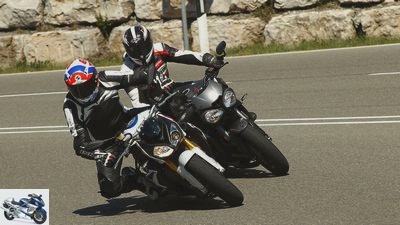
bilski-fotografie.de
7/17
BMW S 1000 R and Triumph Street Triple RS in country roads comparison.
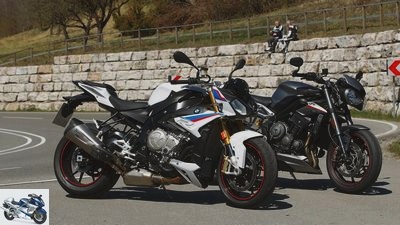
bilski-fotografie.de
8/17
Power as a subject for discussion. Both have more than enough of it on the country road.
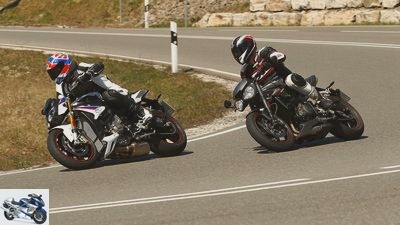
bilski-fotografie.de
9/17
BMW S 1000 R and Triumph Street Triple RS in country roads comparison.
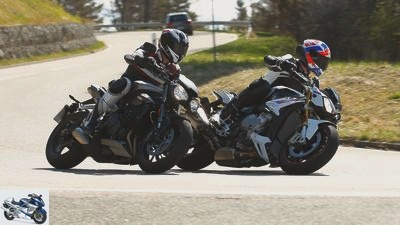
bilski-fotografie.de
10/17
BMW S 1000 R and Triumph Street Triple RS in country roads comparison.
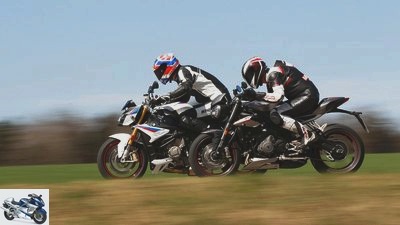
bilski-fotografie.de
11/17
BMW S 1000 R and Triumph Street Triple RS in country roads comparison.
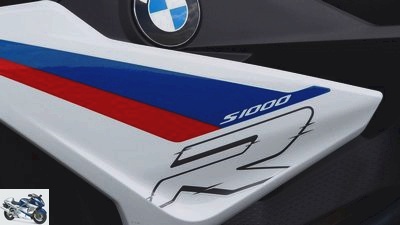
bilski-fotografie.de
12/17
BMW S 1000 R and Triumph Street Triple RS in country roads comparison.

bilski-fotografie.de
13/17
BMW S 1000 R and Triumph Street Triple RS in country roads comparison.
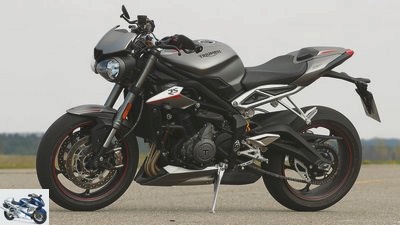
bilski-fotografie.de
14/17
BMW S 1000 R and Triumph Street Triple RS in country roads comparison.
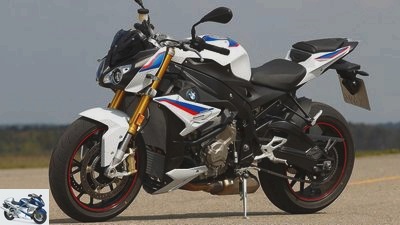
bilski-fotografie.de
15/17
BMW S 1000 R and Triumph Street Triple RS in country roads comparison.
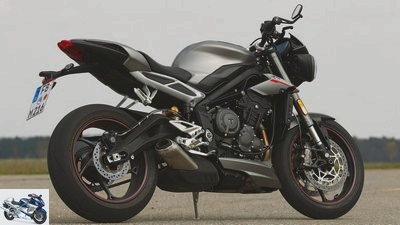
bilski-fotografie.de
16/17
BMW S 1000 R and Triumph Street Triple RS in country roads comparison.
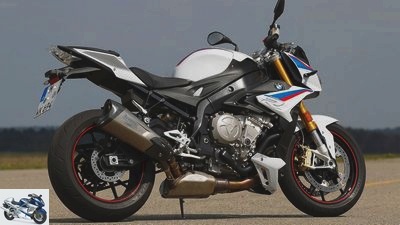
bilski-fotografie.de
17/17
BMW S 1000 R and Triumph Street Triple RS in country roads comparison.
BMW S 1000 R and Triumph Street Triple RS in comparison
Highway duel
Power makes you fast. But is that really true on the country road? Or does a lot of performance just mean stress for the driver and material? A self-experiment with the new Triumph Street Triple RS and the BMW S 1000 R..
KLar everyone already knows the outcome of this story. The Bavarian row four has the higher performance. If the driver strangles the gas properly, the Triumph driver only sees the taillight, which is getting smaller and smaller. There is something to it.
Buy complete article
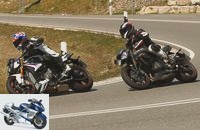
BMW S 1000 R and Triumph Street Triple RS in comparison
Highway duel
Pure theory
The performance of the two motorcycles corroborate this assessment. When it comes to the acceleration measurements, the Triumph is in no position to nibble at the supremacy of the BMW. If they are still close together during the sprint up to 100 km / h, only a tenth separates them, the gap up to 140 km / h increases to almost 0.5 seconds – in favor of the BMW.
Different measurements, same result: The BMW is also in the lead in the pull-through test in sixth gear and in two extra measurements in third and fourth gear. That would be the end of the story. And yet only half the truth would be told. Because real life is only a pure acceleration or pulling test in very rare cases. And more importantly, because there are legal limits in reality.
The limit on country roads is 100 kilometers per hour. We admit it: sticking to it is not always easy. Nevertheless: The speed range most frequently used on country roads should be between 50 and 120 km / h. This quickly turns into a frenzy. Which raises the question of why everyone is looking for performance within what is permitted. Even a 125cc can easily run over 100 km / h – and that with the 15 horsepower usual in this class. Even if one or the other overtaking maneuver is pending or a stretch of the motorway should not end in the slipstream of a truck driving ahead: 40 brisk ponies in two-wheel engines should be enough.
At least that’s the theory. Nevertheless, almost all motorcyclists find a lot of power really good. Deep down, we are all still quartet players for whom only the next trick counts. This is by no means an exaggeration. The registration numbers of high-performance motorcycles prove it – across all categories. Whether enduro, tourer, athlete or naked bike: Power counts in all categories. More than 40 percent of those who decide to buy a new motorcycle always want more than 73 kW of power. For tourers and athletes, the proportion is even over 70 percent. Coziness still counts for choppers. The majority of them choose models with a maximum output of 57 kW. But why is it like that? The quartet-winning gene offers an explanation. Another is: performance turns you on. It is simply a good feeling to let an S 1000 R cheer briefly in the five-digit range. How that marches, how that pushes forward. Endless pressure. Madness. A short dance on the knife edge. Motor abundance makes you happy. And even if the throttle valves do not release the full cross section, this feeling of being able to but not having to is an uplifting one. There is always something going on. That makes you sovereign.
practice
So much for the theoretical part of the discussion. Practice on country roads conveys a different picture, because using the full engine power of an S 1000 R also involves dangers. Quite honestly: Really nobody wring the potent naked on the country road mercilessly. If you are just short of the limiter at the apex of a curve, you should ideally send 116 Nm to the rear wheel. A stress test for traction control and an endeavor that means tremendous concentration and enormous stress for short-term fun. In addition to the performance curves, the tractive forces of the two motorcycles underpin why this is so. Letting the gas on the BMW stand still in first gear at just over 50 km / h means increasing the pulling force from 3500 Newtons to a good 4200 Newtons within a few revolutions. With a weight of the motorcycle including the driver of 300 kilos, the tire would ideally be expected to be 3000 Newtons. Because of the short wheelbase, the front wheel desperately searches for ground contact much earlier, so the traction control has to intervene.
The Triumph Street Triple RS is more sociable, you could almost say “harmless”. With 128 horses measured, the three-cylinder is good at music, with a full tank of 190 kilograms it weighs 17 kilograms less than the non-obese BMW, seasoned with more compact dimensions. In addition, a look at the tractive forces reveals that the RS also shovels a lot of Newtons towards the rear wheel in a short speed range from a good 60 km / h, but remains well below that of the BMW. Your power can be dosed more easily and is more controllable. Nonetheless, when the tensile forces increase sharply in a short range of revs, all senses have to be together. Pure concentration is required. This is why the two of them tend to fly through the radii in gears two to four when dancing on the country road, consciously sacrificing part of their performance for tamable propulsion. After all, the brisk country road turn usually takes much longer than the short but very synthetic measurement of pure acceleration values.
In the pleasurable curve dance, the priority between the two is more the driver’s preference than the potency of the subset. In the jumble of bends and turns, both do not run in their limit area, their motor potential proves to be only partially explorable. What counts is the clean and safe line. The times that the BMW moves towards five-digit speeds can be counted on one hand. Rather, its engine works in the range between 6000 and 7000 rpm, where the torque decides to spontaneously soar. Enjoy the abundance on the fly and push the next gear step in using the automatic gearshift. So it goes quickly and smoothly. The picture is almost the same for the Triumph. Only the speeds are a little higher. The extra thrust between 8000 and 9000 revolutions is often used in order to shift into the next higher gear just a little later using the automatic gearshift. A look at the performance curves for comparison reveals that both bikes move briefly in the range of 100 horsepower at the stated speeds. Enough for the country road, and everyone who wants to know will still find enough fire upstairs that wants to be lit..
Power isn’t everything
From now on, the seconds count. The MOTORCYCLE handling course is waiting. Just over 800 meters long, peppered with curves and hairpin bends. Top tester Georg Jelicic is considered a reference. Race-tested and used to life on the slide limit, he chases the two motorcycles around the narrow course. The stopwatch reports intermediate time after intermediate time, the result is clear. With the slim Street Triple RS, Georg achieves ever better times and thus higher speeds than with the S 1000 R. Even in Dynamic Pro mode, the engine power of the BMW turns out to be more of an obstacle than a blessing. Georg often slows down the traction control, the Bridgestone S 20 Evo signals that he has had enough. Triumph is completely different. Your Pirelli Diablo Supercorsa SP copes well with the lower output. In addition, the Streety throws a lean angle in the pan, reports extremely sensitively with its chassis about what is happening under the tires. And it’s much easier to drive. Its low performance may seem unspectacular compared to the S 1000 R, but the bottom line is that it makes you fast.
But only if you know how to use the potential, as the author shows. Even on the angled course, he relies more on well-dosed performance than on dancing to the hair-sharp limit, wiping through the slalom section in gear step two, for example, while the top tester plows through the first. That costs speed, but allows a lot more fun laps where BMW and Triumph are almost on par.
Which shows: Power isn’t everything. In the end it is the driver’s ability that decides what is possible and what is not. It is the limiting factor, because both motorcycles have enough power on board.
MOTORCYCLE conclusion
Back to the initial question: Does power make you fast, or does stress predominate? As the handling course shows, high performance does not necessarily mean better times. Here control counts more than the mere ability to accelerate, too much power is difficult to handle. Especially since there are hardly any situations in everyday life, even with the Triumph, in which the throttle valves are fully open over a long period of time. And yet: The performance of the two is also good as a formidable source of joy, it’s just fun. Point!
Related articles
-
Triumph Street Triple series test
Rossen Gargolov 32 pictures r-photography.info 1/32 Triumph Street Triple RS: power 123 hp, weight 190 kg, price 11600 euros Triumph Street Triple S: …
-
Triumph Speed Triple and Triumph Street Triple R in comparison
Rivas Family duel: Triumph Speed Triple / Street Triple R Triumph naked bikes in comparison Few motorcycles embody rebellion and freedom as sporty and…
-
BMW R 1200 R, Triumph Speed Triple and Honda CB 1000 R in comparison test
Bilski 48 photos Bilski 1/48 Triumph Speed Triple. Bilski 2/48 Curve artist. As is typical for Honda, the Honda CB 1000 R also makes it easy for its…
-
Triumph Street Triple RS in the 50,000 km endurance test
Mona Pekarek 30 pictures Mona Pekarek 1/30 Editor Mona Pekarek was allowed to run the Streety for five days at the Col de l’Espigoulier. Mona Pekarek 2/30 …
-
Comparison test Ducati 900 SS against Honda VTR 1000 against Laverda 750 S Formula
Comparison test Ducati 900 SS against Honda VTR 1000 against Laverda 750 S Formula Who dares, the twint Brand new and already in the big comparison test. The Ducati …
-
MV Agusta Brutale 800 versus Triumph Street Triple R
Jahn 15 pictures Jahn 1/15 The hot naked bikes: MV Agusta Brutale 800 and Triumph Street Triple R in a comparison test. Jahn 2/15 The …
-
Ducati Multistrada 1200, Kawasaki Versys 1000 and Triumph Tiger 1050 in the test
Gargolov Funbikes in comparison test Ducati Multistrada 1200, Kawasaki Versys 1000 and Triumph Tiger 1050 With bag and pack on a big tour or simply …
-
Comparison test: Harley-Davidson Dyna Street Bob, Triumph Thunderbird ABS
Gargolov Harley-Davidson Dyna Street Bob, Triumph Thunderbird ABS Comparison Test Heavy Chunks Does Heavy Metal Really Make Happy? Editor Rolf …
-
35 pictures 1/35 BMW S 1000 R, Ducati Monster 1200 S, KTM 1290 Super Duke R and Triumph Speed Triple R in comparison …
-
Comparison test all-rounder Honda Hornet 900, Triumph Speed Triple, Yamaha FZS 1000 Fazer
Comparison test of all-rounders Honda Hornet 900, Triumph Speed Triple, Yamaha FZS 1000 Fazer Free radicals Undisguised, light and strong: Honda Hornet 900 ….